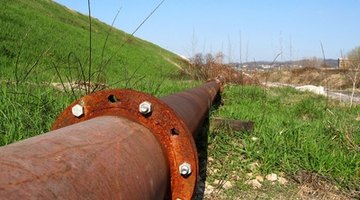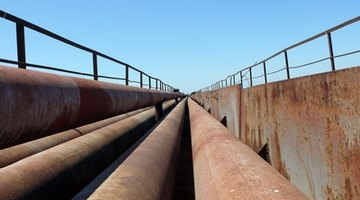How to Calculate Flow Based on Differential Pressure
Daniel Bernoulli first defined the relationships between pressure drop and stream velocity in flowing systems in the 1700s. Later, the Bernoulli Principle would lead developers in the area of flow measurements in straight streams such as in pipes. Today, much pressure-related flow instrumentation finds its origin in this time-proven technology. You can use the same methodology to calculate flow based on differential pressure readings.
Water Flow Calculation

-
Define the liquid flow application. In this example, water flow is being monitored from a new deep well to determine its capacity. Pressure taps at either end of a 100-foot section of 1-inch ID (inner diameter) Schedule 40 PVC plastic pipe have been connected to a differential pressure indicator that reads out 96 inches H2O pressure drop when the well is flowing at peak capacity. With this information, you can calculate water flow rate through the pipe and the well's capacity.
-
Convert the 96-inches-H2O differential pressure into pounds-per-square-inch (psi) differential pressure. Since each psi of head loss is equivalent to 27.71 inches of water column height, then 96 inches/27.72 inches = 3.464 psi differential pressure.
-
Consult the PVC Pipe Friction Loss Chart for 1-inch diameter Schedule 40-PVC plastic pipe. The reading for 25 gallons per minute (gpm) is 14.2 psi friction loss. Because the flow varies as a proportion of the square root of pressure difference, divide your 3.464 psi pressure drop by 14.2 psi pressure drop = 0.2439. Extracting the square root yields 0.4939 x 25-gpm = 12.35 gpm flowing at the 3.464 psi differential pressure.
-
Verify the reasonableness of your calculation by cross-checking with an online calculator. The difference in flow rate is ((12.35-12.22)/12.35 = 1 percent of flow, which is reasonable for flowing systems.


Air Flow Calculation
-
Define the air flow application. Schedule 40 steel pipe is often used to carry compressed air throughout industrial facilities. In this case, a 100-foot length of 1-inch Schedule 40 Steel Pipe has 40-psi air flowing through it. If the pressure loss through the pipe is 1.6-psi, you can calculate the air flow in standard-cubic-feet-per-minute (SCFM).
-
Look up the air flow data in the chart for 1-inch Schedule 40 steel pipe, which has a 1.05-inch ID. Air at 40 psi losing 5 percent of its pressure or 40-psi x 0.05 = 2.0 psi through 100 feet of pipe is flowing at a rate of 62-SCFM.
-
Calculate the air flow for 40 psi air through the same system losing 1.6 psi to frictional losses, on the basis that flow of air at a given density (same pressure and temperature conditions) will vary proportionately as the square root of differential pressure decrease. Therefore, 1.6-psi measured loss (differential pressure) / 2-psi loss from the chart ) = 0.8. Extract the square root of 0.8 and multiply it by the flow rate with a 2-psi differential. This yields 0.8944 x 62 = 55.45-SCFM with a 1.6-psi differential pressure reading.

References
Resources
Tips
- Manufacturers of pumps, valves, and piping systems have exhaustively tested and published data for their products, which makes flow calculations in given systems easy to calculate and cross-validate.
Warnings
- Extreme caution should always be exercised when using any kind of plastic pipe for compressed air applications because of the possibility of flying fragments if the pipe should burst. Only certain products are rated for compressed air.
- Always wear protective eye wear when working with piping systems.
Writer Bio
Pauline Gill is a retired teacher with more than 25 years of experience teaching English to high school students. She holds a bachelor's degree in language arts and a Master of Education degree. Gill is also an award-winning fiction author.
Photo Credits
- pvc image by Greg Pickens from Fotolia.com
- pressure-gauge image by Dusan Radivojevic from Fotolia.com
- pipeline image by dinostock from Fotolia.com
- steel image by Oleg Guryanov from Fotolia.com
More Articles



